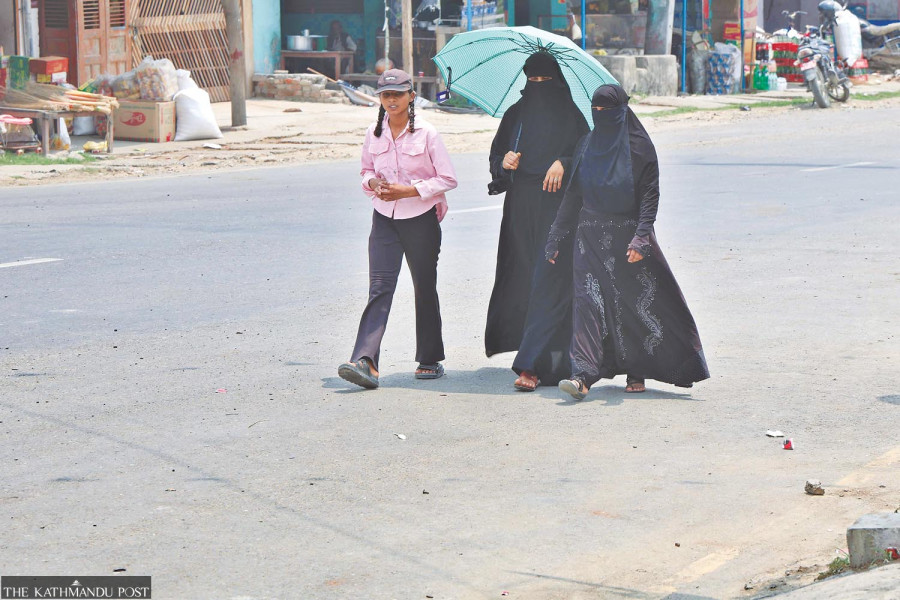Weather
Monsoon came early but no progress even after 9 days
With rain clouds stalled in Koshi Province, no relief from searing heat for Tarai residents. Many schools have suspended classes.
Post Report
The southwest monsoon entered Nepal on June 10, three days earlier than usual.
However, despite this early arrival, the monsoon has not advanced beyond a few districts of the Koshi Province even after nine days.
“Generally, it takes two days for the monsoon to reach the Kathmandu Valley after entering eastern Nepal,” said Pratibha Manandhar, a senior meteorologist at the Meteorological Forecasting Division. “This year, we have not yet issued a second release about the monsoon progress.”
Met officials and locals from Western Nepal, especially those in the Tarai districts, hoped for relief from the scorching heat. They expected that monsoon rains would arrive within days after entering the eastern part of the country. However, the monsoon clouds did not advance from the Koshi Province until Wednesday evening, leaving people struggling with the scorching heat.
Maximum temperatures in several districts of western Nepal have remained over 40 degrees Celsius for the last several weeks, making daily life difficult, especially for the poor people who have to work outdoors during daytime to make ends meet.
Badly affected by the heatwave, several schools in the districts have extended their leave.
On Wednesday, Dhangadhi recorded 42.3 degree Celsius, followed by Nepalgunj 41.5, Birendranagar 40.1, Dipayal 40.2 degree Celsius. Kathmandu recorded 30.6 degree Celsius, according to the met office.
The monsoon season in Nepal generally begins on June 13 and ends on September 23. This year southwest monsoon entered Nepal on June 10, three days ahead of the usual onset date. Last year, it started on June 14, a day later than the normal onset day.
A normal monsoon, supported by the timely arrival of rain, translates into favourable agricultural production, mainly of paddy, and is further linked with the country’s overall economic growth.
The monsoon season, which delivers around 80 percent of the country’s total annual rainfall, generally lasts for 105 days. But, in recent years, it has been taking more time to withdraw.
According to Manandhar, the easterly wind that brought monsoon rainfall in eastern Nepal is not strong enough to displace the westerly winds. Some places in Madhesh, Bagmati, and Gandaki provinces have been witnessing rainfall for the last couple of days, but this is caused by the local system, western disturbances, and low-pressure areas developed in Bihar, India.
“We will issue the next bulletin in a couple of days to inform the public about the monsoon’s progress,” said Manandhar. “As the weather is unpredictable, so is the monsoon rainfall.”
Met officials said that the early onset of the monsoon rain doesn't ensure early progress across the country.
Last year it took three weeks for the monsoon to spread all over the country. “Sometimes, it spreads within two days,” said Manandhar.
The Met Office has forecast above-normal rains and above-average maximum and minimum temperatures this monsoon, which could unleash extreme weather events, such as flooding, inundation, and landslides.
The department’s climate section has issued a weather forecast for four months, from June to September. It said most parts of the country are likely to experience above-average minimum and maximum temperatures and rainfall due to weakened El Nino conditions and the development of La Nina conditions.
El Nino refers to climatic patterns where ocean surface temperatures warm unusually. La Nina is the opposite where the ocean surface cools off.
Nepal is one of the world’s most vulnerable countries to the climate crisis and has witnessed multiple extreme weather events over the past decade and a half.
Evidence suggests that maximum temperatures in Nepal are rising faster, at 0.056 degrees Celsius a year, compared to the global average rise of 0.03 degrees Celsius a year.
Experts say extreme weather events—excessive rainfall in a short period, continuous rains for several days after the monsoon, dry spells, droughts, below-average precipitation, and above-normal winter temperatures—have become more frequent in Nepal.
The National Disaster Risk Reduction and Management Authority estimates that 1.81 million people and 412,000 households will be affected by the monsoon this year. Of them, 83,000 households will be directly impacted, and 18,000 families will require rescue due to monsoon-related disasters.




 4.99°C Kathmandu
4.99°C Kathmandu





